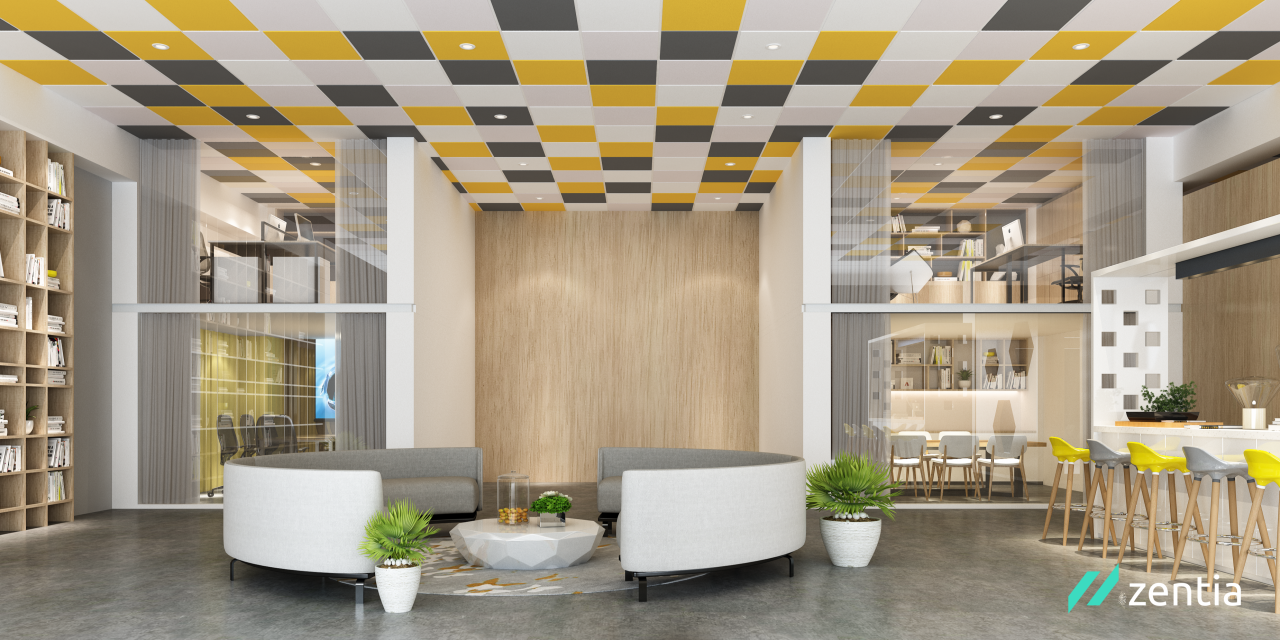In the dynamic landscape of modern education, the concept of zoning and wayfinding has emerged as a pivotal factor in shaping effective and conducive learning environments. Zoning involves the strategic separation of spaces within educational institutions to fulfil specific functions, and accommodate diverse activities. From classrooms and collaborative areas to quiet study zones, the intentional design and implementation of zoning strategies are proving to be essential for creating an environment that maximises learning outcomes, student engagement, and overall wellbeing. Integral to achieving effective zoning and wayfinding in schools is specifying and utilising ceiling systems correctly and effectively.
Zentia’s diverse suspended ceiling tile range has been further expanded with the addition of the Aruba Triangle and 35 colours. Part of the celebrated Aruba Family range, the triangular tiles create a uniform geometric pattern across the ceiling, bringing unique, inspirational design flair to any interior.
Creating Distinct Learning Environments
Schools are required to cater to a diverse range of learning requirements by students. Different subjects, teaching, and age groups demand varying types of environments. For example, you may need to create specific spaces for activities such as group projects, independent study, and interactive learning, so each space needs to suit its purpose to facilitate focused learning, minimise distraction and optimise engagement.
Addressing Noise and Distraction
Noise pollution and distractions are common challenges in any educational setting. Zoning plays a pivotal role in mitigating these issues by allowing the segregation of spaces according to their noise levels and purposes. For instance, quiet zones can be created for concentrated, independent study, whereas other spaces can be zoned for collaborative discussions and interaction. Not only does this enhance the overall learning atmosphere, but it also empowers educators to manage classroom dynamics more effectively.
For effective acoustics in larger, central areas such as assembly halls, Sonify by Zentia provides the perfect solution in the form of acoustic ceiling panels that can be used together to create decorative acoustic rafts, ceiling clouds and islands. Visually stunning designs can be created in the form of rectangles, hexagons, circles or squares, all whilst boasting impressive sound absorption in large open-plan spaces and helping with zoning and wayfinding.
Tailoring to Different Subjects
Each school subject may require a unique learning preference, and zoning allows schools to cater to these individual needs. For example, in creative subjects such as art and performing arts, colourful, vibrant and social settings may encourage inspiration and creativity. However, subjects that require more concentration such as English or maths, would benefit from areas of serenity.
The DecoMesh range from Zentia offers educational settings the ability to create stripped-back, industrial spaces with contemporary class and edgy aesthetics. Made from galvanised steel and powder coated in eight colour options with three different edge details, it provides specifiers with the opportunity to be experimental and create modern, unique and engaging spaces that will capture any student’s attention.
Navigating larger spaces
Starting in a new school can be daunting in several ways, but with effective and cleverly used zoning, the added stress of not being able to navigate around unknown areas and spaces can be diminished. Schools can differentiate rooms and routes around the school by colour, making it easier for students to make sure they are in the right place and ready to learn.
The Aruba family by Zentia offers educational settings the option for vibrant colours and shapes, with a versatile range of acoustic ceiling tiles, designed to meet every project requirement. Available in 35 different colours, the suspending ceiling tiles also provide outstanding acoustic performance, combining Class C sound absorption with a sound attenuation level of 34 dB.
The practice of zoning in schools is not merely about physical separation, but a strategic approach to optimising the learning environment. By creating spaces that cater to diverse learning experiences, addressing noise concerns, fostering collaboration, and supporting emotional wellbeing, zoning emerges as a cornerstone of effective educational design. In an era of varied learning needs and innovative thinking, investing in thoughtful zoning strategies is an investment in the future success and holistic development of students.


